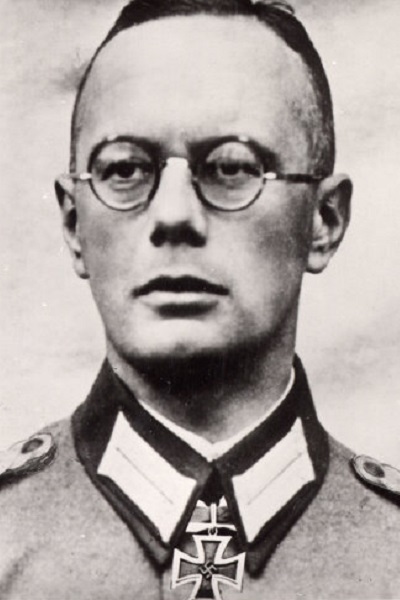Chevallerie, von, la, Botho Hermann Ludwig
- Date of birth:
- August 1st, 1898 (Hanover, Germany)
- Date of death:
- November 16th, 1943 (Klotschkowo, USSR)
- Buried on:
- Soviet War Cemetery Kirovohrad
Plot: 13. Row: 3. Grave: 211. - Nationality:
- German
Biography
During World War 1 he fought with Ulanen-Regiment 20, earning the Iron Cross First and Second Class. Not much else is known about his military career in the Great War. On the 6th of September 1918 he was taken prisoner by the british. He was released on the 1st of November 1919 and was discharged about three weeks later. He lived a civilian life up to October 1934 when he rejoined the army, taking over a company of Infanterie-Regiment 22 (1. Infanterie-Division) of the Gumbinnen Garrison. On the 1st of January 1939 he was commanding the 11th company of the regiment. During the Polish Campaign, on the 9th of September 1939, he was badly wounded (shot into the neck with the round entering the lungs) and was transported to Ortelsburg/Germany for medical treatment. De la Chevallerie took part in the Campaign in the West (commanding 3rd battalion, Infanterie-Regiment 43, 1. Infanterie-Division). When the battalion was transferred to 121. Infanterie-Division and redesignated III./Infanterie-Regiment 408he stayed in command and participated in the campaign against Russia. On the 28th of June he was wounded again (one shot to the head, two into the arm), near Kowno.
Only a day before he had earned himself the Knights Cross, when his battalion attacked russian positions in the forests near Rukla. The enemy there was strong, so originally the attack was supposed to be carried out by the whole division. Having been cut of from artillery support and all other units, de la Chevallerie attacked with a single battalion instead. By the end of the day, III. battalion had taken the soviet positions. Huge amounts of supplies, arms and ammunition were captured. He was awarded the Knights Cross on the 23. of July 1941.
After recovering from his wounds he took command of Infanterie-Ersatz-Bataillon 22 (regimental reserves) in Gumbinnen. In November 1943 (now a Major) we find him commanding Grenadier-Regiment 585 (320. Infanterie-Division) on the Eastern Front. Being wounded again on the 14th of November 1943, he succumbed to his wounds on the following day. He was promoted to the rank of Oberst posthumously.
Do you have more information about this person? Inform us!
- Period:
- Second World War (1939-1945)
- Rank:
- Major
- Unit:
- Kommandeur, I. Bataillon, Infanterie-Regiment 408, 121. Infanterie-Division
- Awarded on:
- July 25th, 1941
“Not hesitating due to the lack of support, nor the lost communications with the artillery, La Chevallerie decided to attack the barracks at Rukla (which was located in the neighbouring sector). By his personal influence and example he inspired his men forwards and shortly before dusk he captured this extremely important location. The enemy couldn’t resist the onslaught of La Chevallerie’s Bataillon. They fled to the east and left behind armoured vehicles and countless quantities of materiel in the hands of the Regiment. Through this deed La Chevallerie contributed to the decisive fighting at the frontline sector east of Kowno.”
- Period:
- Second World War (1939-1945)
- Awarded on:
- October 29th, 1939
- Period:
- Second World War (1939-1945)
- Awarded on:
- 1939
- Period:
- Second World War (1939-1945)
- Period:
- Second World War (1939-1945)
- Period:
- Second World War (1939-1945)
- Period:
- Second World War (1939-1945)
- Period:
- Second World War (1939-1945)
- Period:
- Second World War (1939-1945)
Sources
- Photo 1: Igor Poul
- - THOMAS, FRANZ & WEGMANN, GüNTER, Die Ritterkreuzträger der Deutschen Wehrmacht 1939-1945, Biblio Verlag, Osnabrück, 1998.
- Knights Cross holders report on the invasion of Poland 1939 – Oberst de la Chevallerie – 1. Infanterie-Division | Gott mit uns! German Military History 1848-1945











